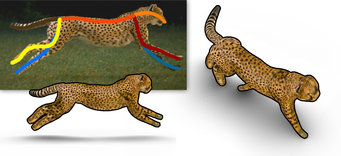3D animation – incredibly easy
New software makes it possible to generate animated three-dimensional figures of animals from short videos
Whether it's King Kong for Hollywood's dream factory or apes in a computer game: even experts usually need several days using conventional programs to recreate animals in three-dimensional digital form, and to animate them in a lifelike way. Now, researchers at the Max Planck Institute for Informatics in Saarbrücken have developed software that even non-specialists can use to create such 3D figures in just a few minutes – to do this, they need nothing more than a video that shows the animal moving. Users only need to indicate the lines of the head, body and limbs, the software does everything else. The program could be of interest to the film and computer game industry but also to non-specialists, who can use it to easily produce animated animal films.

A leopard sprints through a savannah grassland. The video sequence that shows the animal doing this lasts only a few seconds. But it is enough to calculate a three-dimensional, digital, moving image of the animal. This is made possible thanks to software developed by Bernhard Reinert and Hans-Peter Seidel from the Max Planck Institute for Informatics and Tobias Ritschel from University College in London. In addition to a video that shows the moving animal, the program requires only minimum intervention from the respective user. For example, in order to bring the leopard to life as a 3D creature, the user must sketch out the limbs and skeleton, just like a stick figure, on an individual video frame.
To do this, the researchers developed a user interface that resembles a simple paint program. Using this program, a few mouse clicks are all that are needed to paint the leopard's tail with an orange line and highlight the spine, head, front and back legs with additional coloured lines. The software transfers these markings to all the frames in the video sequence so that the lines are always on the limbs, even if their position changes in the following frames. The user checks that the program has captured the limbs correctly by controlling the five frames and, if necessary, correcting them manually. “This is where all previous approaches that automate the recognition of limbs have failed. We therefore developed a new computational method based on specific random processes known as Markov chains”, explains Bernhard Reinert, who completed his doctorate at the Max Planck Institute for Informatics just a few weeks ago.
Just a few minutes to make a model for a 3D print
If the user confirms that the software has correctly identified the leopard's limbs in the crucial five frames, the program automatically creates the three-dimensional, digital lattice model for the animal. To do this, it separates the two-dimensional image of the leopard from the foreground and the background and replaces the sketched limbs with cylinders that vary in height and diameter until they fit every frame. “The process resembles the effort to shape an animal out of an elongated balloon, but is much more exact in terms of the individual segments”, explains Reinert. In the last step, the leopard's coat is copied from the image on which the limbs and skeleton were marked and is then dragged over the 3D lattice model as the “texture” – and the three-dimensional leopard model is now complete.
In this way, users receive a good 3D model in just a few minutes that can be used directly for animations or a 3D print. “You can refine the model even further if you need an even higher quality”, explains Tobias Ritschel, Senior Lecturer at University College London. However, the unedited 3D model is already so good that it could be sent to a 3D printer straightaway in order to print a corresponding sculpture on the basis of the digital model.
A zoo of animal models from short video clips

The researchers tested their software on several animal video clips that they found on YouTube and thus created an entire zoo of 3D models. Short videos are ideal, as often only the animal is moving in these videos, and the camera doesn’t swivel wildly back and forth, which causes difficulties for the software. The 3D animal models can be displayed in various poses and with different coats or skins. They can also be cloned, in order to create an entire group of leopards from the template of one leopard, for example. This was previously only possible if a lot of work was done by hand.
In another study that they conducted, the researchers showed how quickly users could produce impressive animal 3D models using the software. School children and students who were already able to use a current program for generating 3D models took part in the study. The researchers asked some of the participants in the study to digitally recreate a simple animal using the new software – a task that this group managed to do in just a few minutes. The other test subjects, on the other hand, who were working with the conventional software, were still not satisfied with the result after half an hour.
As the new software is so easy to use, it enables non-specialists to create 3D models of their pets based on short videos, and to animate them in films. The program could also make life easier for specialists working in the film and video game industry. Although the program’s models are not yet quite as good as the animations that are seen in Hollywood productions, which entail a huge amount of work, they could provide professional 3D graphic artists with a fast, good-quality template that they can then further refine.
GB/PH













